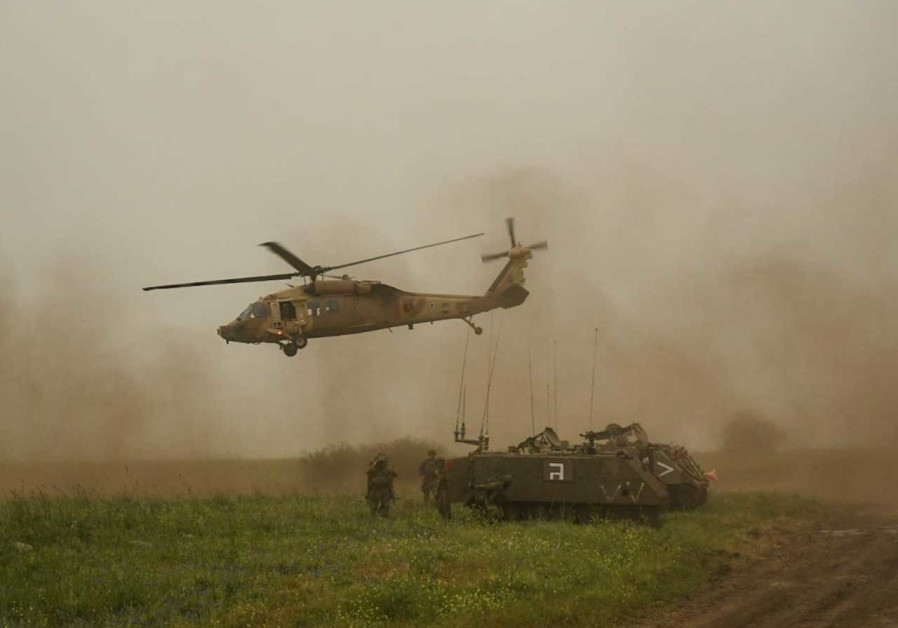Defending the border from Hezbollah infiltration, destroying anti-tank missile infrastructures and maneuvering inside enemy territory are just some of the skills that were exercised in the 188th Armored Brigade drill that was completed on Thursday.
The brigade’s drill was the culmination of a 17-week training session. The 53rd, 71st and 74th Armored Corps battalions and the 605th Engineering Corps battalion all held battalion-level drills beforehand.

“There’s no way that tanks or infantry will fight on their own,” OC 53rd Armored Corps battalion Dori Sa’ar told The Jerusalem Post at the drill’s venue. “They always fight in the joint-combat formations. In this brigade drill, we see all sorts of exercises, including all these components of a joint-combat formation.
“For instance, we exercised evacuation of wounded troops by heavy-lift helicopters or assistance with firepower from artillery batteries and attack helicopters.”
This comes as part of the combat doctrine that IDF Chief of Staff Lt.-Gen. Aviv Kohavi is implementing in the military, including multi-domain battle.
According to this doctrine, the military does not fight with different types of troops, such as infantry, tanks and fighter jets in different domains, including air, underground and at sea. Instead, all units are fighting the same battle together.
The role of tanks is to provide powerful firepower that can hit enemies from afar and have the ability to detect enemies with advanced sensors, according to the new doctrine.
The abilities to perform these duties in combat were given to the 188th Armored Brigade this past year, which was dubbed as the “transformation year.” It started operating the Merkava IV-Mem 400 tanks, the most advanced tank in the IDF, which also included the advanced Digital Army 750 communication system.
“This major change of tanks happens once every 25 to 30 years,” Sa’ar said. “This new tank has the most advanced control-and-command system, which allows us to be in communication with all forces around us – infantry, Air Force, artillery and Engineering Corps – and through that, we could ‘close fire circles’ and engage quickly with the enemy.”
“It also has systems that help with revealing the enemy,” he said. “The [Merkava IV-Mem] 400 has also advanced TROPHY system abilities. This system knows how to initiate attacks and not only be effective in protecting the tank.”
Over the past few years, the improvements that the Merkava tanks underwent makes them a vital part in the future war, said Sa’ar.
“There’s no [IDF] ground force that could compete with it,” he said. “What a single tank crew brings to the battlefield – just one crew – is above and beyond [the expected]. I heard that people are saying the tanks are the weapons of the past. They said it’s too big and stuff like that. That’s nonsense. The pace of IDF maneuvers will be determined by the tanks.”
“The new systems that were installed on the tanks, which improve its survival abilities, help this maneuver and allow the tank crew to do their job – locate the enemy and destroy it” he added. “The new TROPHY system can already tell you what is the source of an attack and destroy it, and I can’t say more than that.”
A new force that joined this exercise is the Logistic Assistance Unit, a new battalion that is meant to be in each scenario and is in charge of making sure that the logistic needs of the combat battalion are met.
The initiative to create such a unit came as part of the lessons that were learned after the Second Lebanon War, in which soldiers complained that they did not have enough ammunition and food.
“We are the first brigade to have such an auxiliary unit,” Sa’ar said. “The duty that this unit is given help the battalion commander focus on the combat and takes off their shoulders the worries of making sure that the logistics operation is running without problems. This unit is made of logistics people and combat warriors, and due to this mixture, it could work independently and do its job. It is a major improvement that could change the way a battalion fights on the battlefield.”
